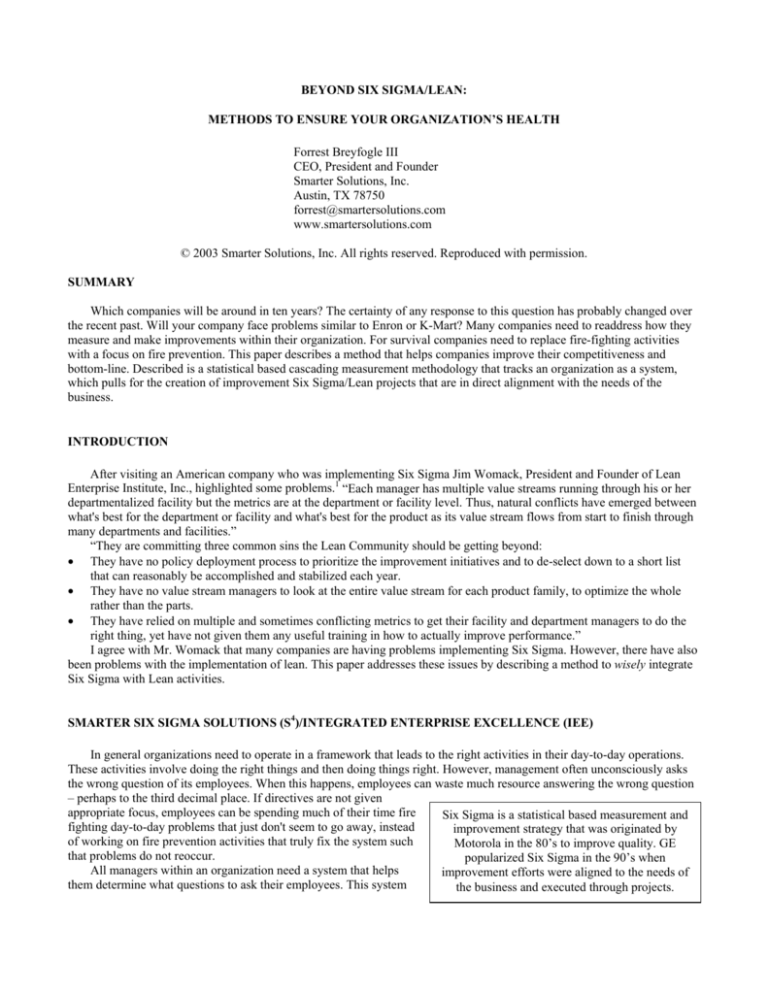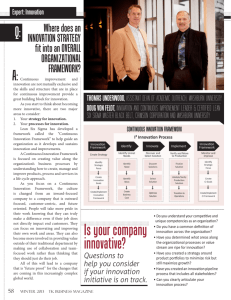
BEYOND SIX SIGMA/LEAN:
METHODS TO ENSURE YOUR ORGANIZATION’S HEALTH
Forrest Breyfogle III
CEO, President and Founder
Smarter Solutions, Inc.
Austin, TX 78750
forrest@smartersolutions.com
www.smartersolutions.com
© 2003 Smarter Solutions, Inc. All rights reserved. Reproduced with permission.
SUMMARY
Which companies will be around in ten years? The certainty of any response to this question has probably changed over
the recent past. Will your company face problems similar to Enron or K-Mart? Many companies need to readdress how they
measure and make improvements within their organization. For survival companies need to replace fire-fighting activities
with a focus on fire prevention. This paper describes a method that helps companies improve their competitiveness and
bottom-line. Described is a statistical based cascading measurement methodology that tracks an organization as a system,
which pulls for the creation of improvement Six Sigma/Lean projects that are in direct alignment with the needs of the
business.
INTRODUCTION
After visiting an American company who was implementing Six Sigma Jim Womack, President and Founder of Lean
Enterprise Institute, Inc., highlighted some problems.1 “Each manager has multiple value streams running through his or her
departmentalized facility but the metrics are at the department or facility level. Thus, natural conflicts have emerged between
what's best for the department or facility and what's best for the product as its value stream flows from start to finish through
many departments and facilities.”
“They are committing three common sins the Lean Community should be getting beyond:
• They have no policy deployment process to prioritize the improvement initiatives and to de-select down to a short list
that can reasonably be accomplished and stabilized each year.
• They have no value stream managers to look at the entire value stream for each product family, to optimize the whole
rather than the parts.
• They have relied on multiple and sometimes conflicting metrics to get their facility and department managers to do the
right thing, yet have not given them any useful training in how to actually improve performance.”
I agree with Mr. Womack that many companies are having problems implementing Six Sigma. However, there have also
been problems with the implementation of lean. This paper addresses these issues by describing a method to wisely integrate
Six Sigma with Lean activities.
SMARTER SIX SIGMA SOLUTIONS (S4)/INTEGRATED ENTERPRISE EXCELLENCE (IEE)
In general organizations need to operate in a framework that leads to the right activities in their day-to-day operations.
These activities involve doing the right things and then doing things right. However, management often unconsciously asks
the wrong question of its employees. When this happens, employees can waste much resource answering the wrong question
– perhaps to the third decimal place. If directives are not given
appropriate focus, employees can be spending much of their time fire
Six Sigma is a statistical based measurement and
fighting day-to-day problems that just don't seem to go away, instead
improvement strategy that was originated by
of working on fire prevention activities that truly fix the system such
Motorola in the 80’s to improve quality. GE
that problems do not reoccur.
popularized Six Sigma in the 90’s when
All managers within an organization need a system that helps
improvement efforts were aligned to the needs of
them determine what questions to ask their employees. This system
the business and executed through projects.
should also be able to help employees answer these questions for the business. A system needs to be created that not only
uses data to make the right decisions for their organization they must also create the means where meaningful data is
available in a form that is useful to organizations throughout the supply chain.
Organizations create strategic plans and policies. They also create goals that describe the intent of the organization.
These goals should have measurable results, which are attained through defined action plans. The question of concern is how
effective and aligned are these management system practices within your organization? Many organizations have an
opportunity for improvement in this area, which can significantly improve their bottom-line. A Smarter Six Sigma Solutions
(S4 ) or Integrated Enterprise Excellence (IEE) approach offers a solution to these challenges. The S4/IEE approach is similar
but yet more powerful than a traditional Six Sigma on Lean approach.2
Within an S4/IEE management system, satellite-level and 30,000-foot-level Metrics3 are created and tracked. This
approach leads to measuring the organization as a system at different levels as shown in Figure 1, which are aligned.
Satellite-Level
30,000-Foot-Level
© 2002 by Smarter Solutions, Inc. (smartersolutions.com), Reproduced with permission.
Figure 1. Levels of View for the Enterprise
Long-term improvement opportunities to the overall system can then be easier identified and scoped as S4/IEE
improvement projects. Trained practitioners then follow a structured roadmap for executing S4/IEE projects, which can
involve not only quality improvements but also cycle time improvements that reduce waste within an organization.
Satellite-Level metrics are high level business metrics. More information can be gleaned from data presented in this
format, as opposed to examining quarterly numbers as a single entity in
a tabular format or as a dashboard number. Data presented in this
Lean is a methodology that focuses on the
format can be useful for executives when creating their strategic plans
elimination of waste: overproduction ,
and then tracking the results of these strategic plans. With an S4/IEE
waiting, transportation, inventory, overstrategy, action plans to achieve organizational goals center around the
processing, motion, and defects.
creation and implementation of Six Sigma projects, as shown in Figure
2.
Business Measures and Goals
Satellite-Level
Strategic Plans
Identify High Potential Areas
Projects
30,000-Foot-Level
© 2002 by Smarter Solutions, Inc. (smartersolutions.com), Reproduced with permission.
Figure 2. Aligning improvement projects to the overall needs of the business.
Metrics at the 30,000-foot-level are high level operational or Six Sigma/Lean project metrics. These metrics link Six
Sigma activities to business strategies and goals. Use of the right metric drives the right activity. Also, these metrics can
significantly reduce fire fighting activities. In addition, this form of tracking is also useful for balanced scorecard metrics.
The S4/IEE strategy tracks an organization at a Satellite-Level using a statistical control chart. Metrics such as capital
utilization, growth, revenue, profit, and customer satisfaction are tracked in this time-series format measuring the overall
system output beyond the bounds of quarterly or fiscal accounting periods. A Satellite-Level chart is often compiled and
tracked monthly.
The control chart format for this presentation separates special cause events from common cause variability. This simple
presentation of data can lead to the dissemination of questions throughout the organization, which encourage the execution of
projects that improve the overall system, as opposed fire fighting the up and down variability excursions of the system as
though they were special cause.4 Using lean terminology we could say that the measurement systems pulls for the creation of
projects.
The alignment of 30,000-foot-level metrics to satellite-level metrics is critical. Traditional operational metrics that can be
tracked at the 30,000-foot-level are defective/defect rates, cycle time, waste, days sales outstanding, customer satisfaction, ontime delivery, number of days from promise date, number of days from customer requested date, dimension, inventory, and
head count. Metrics at the 30,000-foot-level are also tracked on a statistical control chart that has infrequent
subgrouping/sampling2, e.g., daily or weekly. This charting approach separates common cause occurrence from special cause
events. Reacting to out-of-specification conditions when a process is not capable of consistently meeting these requirements
is fire fighting, i.e., treating common cause issues as thought they were special cause. Typically fire-fighting activities require
much resource and address only short-term fixes.
An S4/IEE business strategy helps organization understand and improve the key drivers that affect the metrics and
scorecards of their enterprise. Tracking the overall system at this level can be a stimulus to the creation of long-lasting
change. For example, retribution by executive management for missing arbitrarily quarterly objectives can change to more
timely questions about the status of S4/IEE projects that are addressing the improvement of key processes, which are aligned
to the overall business metrics.
S4/IEE PROJECT EXECUTION
Figure 3 shows how projects within S4/IEE follow a 9-step Define-Measure-Analyze-Improve-Control (DMAIC)
roadmap. Improvements to the process will then be demonstrated in the 30,000-foot-level metric. The financial impact from
this change can then be determined.
30,000 Foot-Level Metric
Customer
needs
Key Process
Output Variable
Customer
needs
Frequency of
non-conformance
Frequency of
non-conformance
Bottom-line benefit is
the translation of these
differences into money
Define •Measure •Analyze •Improve •Control
D
Plan
Project
and Metrics
M
Define
Project
Measure
Baseline
Project
Consider
Lean
Tools
A
Passive
Analysis
MSA
I
C
Proactive
Testing
Control
Wisdom
of the
Organization
© 2002 by Smarter Solutions, Inc. (smartersolutions.com), Reproduced with permission.
Figure 3. S4/IEE 30,000 Foot-Level project tracking and execution
Voice of the customer (VOC) issues need to be addressed both at the satellite-level and the 30,000-foot-level project
level. At the satellite-level we need to have a system that captures and tracks the true voice of the customer. This involves
more than just sending out survey forms that people may or not answer. It involves the creation of a meaningful customer
feedback process, which encourages activities that are aligned with the needs of both internal and external customers. The
S4/IEE business execution strategy has the steps noted in Figure 4 within the VOC sub-process.
Collecting
Voice of
Customer
Define your
Customer
Start
Obtain
Customer
Wants, Needs,
and Desires
Assure that
Project is
Meeting
Customer
Needs
Ends
© 2002 by Smarter Solutions, Inc. (smartersolutions.com), Reproduced with permission.
Figure 4. Collecting Voice of the Customer
After the customer is defined, their wants, needs, and desires need to be determined. This information can come from
several sources, which can lead to the formulation of improvement projects, as illustrated in Figure 5.
Voice of the
Customer
Data
Warehouse
Complaints
S4 Project
Surveys &
focus groups
Opportunity for
Improvement
Management
Systems
Customer
Requirements
Audits
© 2002 by Smarter Solutions, Inc. (smartersolutions.com), Reproduced with permission.
Figure 5. Alignment of VOC needs to S4/IEE project selection
CONCLUSION
Creating an effective system to track the effectiveness of meeting customer needs at the satellite-level and 30,000-footlevel is not easy. However, after this VOC system is established, systems can be created to help tracking and report these
metrics along with other meaningful metrics that area aligned with the needs of the business enterprise as a whole.
REFERENCES
1.
2.
3.
4.
Womack, Jim, Substituting Money for Value Stream Management, Lean Enterprise Newsletter, Nov 12, 2002.
Breyfogle, Forrest W. III Implementing Six Sigma, second edition, Wiley 2003.
Breyfogle, Forrest W. III, David Enck, Phil Flories, and Tom Pearson, Wisdom on the Green: Smarter Six Sigma
Business Solutions, Smarter Solutions Inc., 2001.
Breyfogle, Forrest W. III, James M. Cupello, and Becki Meadows (2001) Managing Six Sigma, Wiley, 2001.
Smarter Solutions and satellite-level are registered service marks of Smarter Solutions Inc. Smarter Six Sigma Solutions, S4,
and 30,000-foot-level are service marks of Smarter Solutions, Inc.








